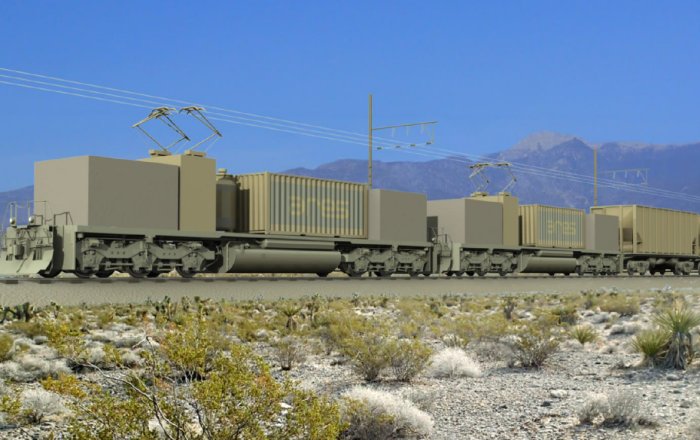
ARES energy storage shuttle train
While it’s not the sort of solution you could install at home, rail based energy storage may prove to be a viable option for grid-scale applications and an alternative to pumped hydro in some scenarios.
The USA’s ARES is developing an energy storage solution that involves the use of electric rail cars, heavy blocks of concrete and regenerative braking.
The system is “charged” by using surplus electricity from a wind or solar farm, or off-peak energy, to transport rail cars carrying heavy concrete blocks to the top of a hill or up a grade. The cars are released when energy is needed and as they move back down, the rate of descent is controlled by regenerative braking that in turn creates the electricity.
ARES has patented two related technologies; a traction drive system for grades of less than 10% (6 degrees) and its Ridgeline funicular cable drive technology that can operate on slopes up to 50% (25 degrees).
ARES says among the advantages of its system over pumped hydro is it doesn’t require water, any dams or reservoirs to be constructed, it can be built quickly and is easily removed when no longer required.
The company claims a round-trip efficiency (power in, power out) of up to 78% and a current cost comparable to pumped hydro.
The system can be scaled from 20MW for ancillary services only to 3GW regional energy storage hubs with 16-24GWh energy storage capacity.
“One of the best things about ARES technology is its low technical risk. Rail transport is an age- old technology that has evolved into one of the most efficient modes of transportation ever devised,” says ARES’ Director of Engineering, Matt Brown. ” Its cost and performance are well known and commercially viable as an energy storage system when integrated with state-of-the-art automation, control and power systems.”
In April this year, ARES received approval from the USA’s Bureau of Land Management to proceed with a 50MW project in Southern Nevada, which will deliver ancillary services support and help stabilize the region’s electricity grid. Control facilities will respond to grid requirements by controlling the speed and number of shuttle trains operating. ARES says the system will have a far faster ramp-rate than pumped-hydro storage.
The pilot project will see shuttle trains weighing 8,700 tonnes running on a single track approximately 9 kilometres long, with electricity transmitted via a parallel overhead power distribution line. Each shuttle train will consist of two electric locomotives and multiple weighted rail cars.
An overview of ARES technology can be downloaded here (PDF).

 RSS - Posts
RSS - Posts



Speak Your Mind